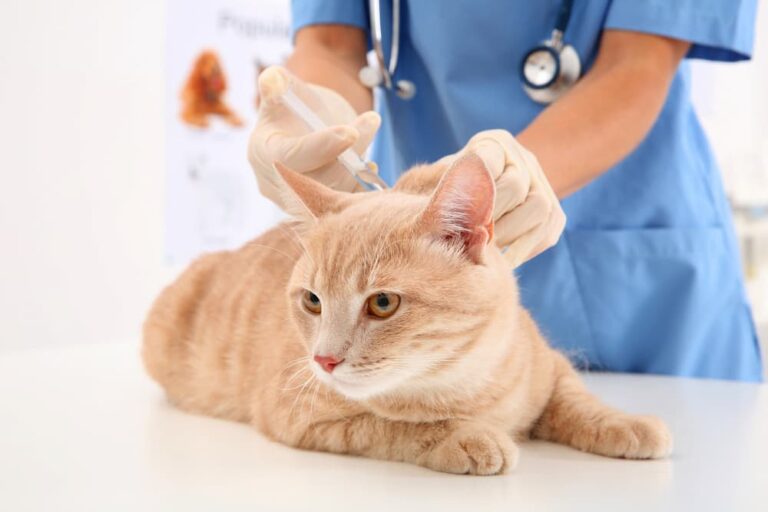Cat Vaccine Reactions: Signs and What to Do

As a pet parent, you’re probably accustomed to taking your cat to the veterinarian for their vaccines. And while it may seem routine, the value of vaccination cannot be overstated. Vaccines play an enormous role in helping your furry family member stay healthy and live longer by preventing serious and fatal illnesses — including rabies, which is deadly to humans and other animals. However, no medical procedure is completely risk-free, and vaccine reactions in cats can happen.
In this article, I’ll help you understand the types of cat vaccine reactions, signs to look for, and what to do if you think your cat is having a vaccine reaction.
Do Cats Develop Vaccine Reactions?
Vaccine reactions are rare in cats, and the overall benefits of vaccines far outweigh their risks. The largest study to date on cat vaccine reactions evaluated medical records of almost half a million cats and found that only 0.52 percent had reported vaccine reactions. However, not all vaccine reactions get reported, so the actual number is probably a bit higher than this. The study found that cats (of any breed) that are around a year old, especially those receiving multiple vaccines in one visit, had the highest risk of developing a reaction. But overall, side effects for cat vaccinations tend to be mild and uncommon. [1]
Most Common Vaccines That Cause Reactions
There are several types of vaccine technologies available. Inactivated vaccines are one type that use adjuvants (a vaccine component that creates local inflammation at the injection site to help stimulate an immune response). Many of the rabies and FeLV vaccines given today are adjuvanted, although non-adjuvanted options are available and widely used as well.
In some studies, adjuvanted vaccines have been linked to a rare cancer called feline injection site sarcoma (FISS). However, it is still not clear if non-adjuvanted vaccines carry less risk, as these have been implicated in FISS as well. To add to the confusion, other injected substances that are not vaccines have also been known to cause FISS. It’s an area requiring more research, and currently, there isn’t enough evidence to say one kind of vaccine is safer than another when it comes to FISS. [1, 2, 3, 4, 5]
Receiving multiple vaccines in one visit can increase the risk of your cat feeling lethargic or feverish for a day or two following vaccines [1]. However, it is common practice to give multiple vaccines during a veterinary visit, and most cats tolerate this well.
Types of Vaccine Reactions in Cats
The vast majority of cats don’t experience adverse vaccine reactions, but what if your feline friend just happens to be one of the unlucky ones who do? The good news is that the most common vaccine reactions are quite mild and usually resolve within a day or two, without any need for treatment. More serious and life-threatening reactions can happen, but these are rare. Here are the main types of cat vaccine reactions:
Nonspecific Immune Response
Vaccines are designed to stimulate the immune system, resulting in a mild inflammatory response but without causing the actual disease. This is the expected and healthy response to vaccination that leads to protection against specific diseases. While most cats feel fine, this immune stimulation may cause some cats to feel a little under the weather for a day or two after their vaccines. This is the most common type of vaccine reaction and is generally mild, with most cats recovering quickly without treatment. This is not the same as a vaccine allergy.
Allergic Reaction (Type-1 Hypersensitivity Reaction)
A true allergic reaction to vaccines is serious. These reactions occur when the immune system has an exaggerated response to a trigger that is usually harmless in others (like a peanut allergy in people). The result is an intense response affecting multiple body systems called anaphylaxis. Vaccines, insect stings, medications, and other environmental exposures can all be potential triggers for anaphylaxis in a susceptible cat.
Usually, a cat must become sensitized first, so the first time they are exposed to the trigger, there may be little to no reaction. However, the next time they’re exposed, the immune system is primed to identify the allergen as a threat and unleash a major allergic reaction. Less commonly, an animal may react upon first exposure to the trigger, called an anaphylactoid reaction. Either way, the symptoms and treatment are the same. Anaphylaxis usually happens fast — typically within 20 minutes of exposure. Without immediate treatment, anaphylaxis can rapidly become fatal.
Thankfully, anaphylactic shock in cats is very rare after vaccines.
Localized Inflammatory Reaction
Cats may develop a localized inflammatory reaction in the area where the vaccine was given. This may cause soreness, redness, or a small lump of inflammatory cells to form. Inflammatory lumps can form within days to a couple of weeks after vaccines and should follow the 3-2-1 rule: they should resolve after 3 months, should be less than 2 cm, and should not continue to grow after 1 month. It’s important that your veterinarian evaluate any lump that forms to ensure it is not something more serious.
Feline Injection Site Sarcoma
Feline injection site sarcomas (FISS) are a rare but serious consequence associated with vaccines and other types of injections. They are estimated to occur in 1 to 4 out of every 10,000 cats [2, 3, 5]. FISS are aggressive cancerous tumors composed of various connective tissues and typically form just under the skin of the injection site.
An injection site sarcoma in cats is locally invasive and can spread to other parts of the body (metastasize), like the lungs, especially in later stages of the disease. These tumors are notorious for embedding deeply in surrounding tissues, making them very difficult to remove fully. Cats can develop sarcomas that are not injection-related, but these tend to behave differently and less aggressively than FISS.
It’s still not clear why some cats develop FISS while others don’t. It is thought that the inflammatory response caused by vaccines and some other types of injections can lead to the formation of FISS in certain cats that may be genetically susceptible.
Signs of Cat Vaccine Reactions

After your cat has vaccines, it’s a good idea to watch for signs of a reaction. Here are some of the main signs to look out for:
Common Vaccine Reactions in Cats
- Mild lethargy
- Decreased appetite
- Mild fever
- Soreness around the injection site
- A small, benign lump that forms at the injection site and follows the 3-2-1 rule
If your cat feels a little off for a day or two, it’s okay to just monitor them at home. If they seem excessively unwell or the symptoms last beyond a couple of days, then contact your veterinarian.
While most lumps that form after a vaccination aren’t cancer, they should still be evaluated by your veterinarian.
Serious Vaccine Reaction Symptoms in Cats
- Difficulty breathing (labored, open-mouth breathing, wheezing)
- Swelling of the face or around the eyes
- Vomiting
- Diarrhea
- Generalized itchiness, possibly with hives (hives are less common in cats than dogs)
- Pale gums
- Collapse
If you notice any of these serious symptoms after your cat has a vaccine, seek immediate veterinary care.
Signs of injection site sarcoma in cats include:
- A firm lump forming at an injection site, anywhere from months to years after an injection
- FISS are generally firm, attached to the underlying tissues (not easily mobile), and can grow quickly
Treating Vaccine Reactions in Cats
In the case of a mild vaccine reaction, such as slight lethargy and a low-grade fever, usually no treatment is required. Most cats will feel completely better within a day or two. You can help your kitty by ensuring they have a quiet place to rest and offering some extra enticing foods, like tuna or some lightly warmed canned food (but never try to force your cat to eat).
If your cat is feeling quite lethargic and refusing to eat or drink, check with your veterinarian. If they feel confident that these effects are from the vaccine and not something else, they may prescribe a dose of an appropriate anti-inflammatory to help your cat feel better, but this usually isn’t necessary. Never give medications such as acetaminophen or ibuprofen to your cat, as these are toxic to them.
Anaphylactic reactions require emergency veterinary treatment. Anti-inflammatory and antihistamine medications are given to halt the exaggerated immune response, epinephrine to counteract dangerously low blood pressure and poor circulation, and possibly other medications to help reduce airway spasms and further stabilize blood pressure. Other emergency measures include IV fluids and oxygen administration (possibly given through a breathing tube placed in your cat’s trachea if necessary). Patients are admitted to the hospital and carefully monitored for the resurgence of any symptoms. [6]
If your veterinarian suspects your cat has developed FISS, they will recommend a biopsy sample to help confirm their suspicion. Because FISS are extremely invasive with high re-occurrence rates, aggressive surgery with wide margins is needed. In addition to surgery, chemotherapy and/or radiation may be recommended in some cases. General veterinarians often refer to board-certified veterinary surgeons and oncologists to help manage these challenging cases.
Vaccine Reactions in Cats: Things to Keep in Mind
While it can feel scary to think about serious vaccine reactions, it’s important to remember these are rare and the benefits of vaccines far outweigh their risks. When it comes to vaccines, there isn’t a one-size-fits-all approach. Your veterinarian should tailor their recommendations to your cat’s particular situation and follow the most current vaccination guidelines to ensure they have the protection they need while minimizing their risk of adverse reactions.
References
- Moore, George E et al. “Adverse events after vaccine administration in cats: 2,560 cases (2002-2005).” Journal of the American Veterinary Medical Association vol. 231,1 (2007): 94-100. doi:10.2460/javma.231.1.94
- Intile, J. and Gareau, A. “Feline Injection Site Sarcomas: Risk Factors, Diagnosis, Staging, and Treatment Algorithm.” Today’s Veterinary Practice. July/August 2021. Accessed online https://todaysveterinarypractice.com/oncology/feline-injection-site-sarcomas
- Hartmann, Katrin et al. “Feline Injection-Site Sarcoma and Other Adverse Reactions to Vaccination in Cats.” Viruses vol. 15,8 1708. 8 Aug. 2023, doi:10.3390/v15081708
- Srivastav, Anup et al. “Comparative vaccine-specific and other injectable-specific risks of injection-site sarcomas in cats.” Journal of the American Veterinary Medical Association vol. 241,5 (2012): 595-602. doi:10.2460/javma.241.5.595
- 2020 AAHA/AAFP Feline Vaccination Guidelines. American Animal Hospital Association. Aug. 2020. Accessed online https://www.aaha.org/resources/2020-aahaaafp-feline-vaccination-guidelines/
- Lyons, J. and Scherk, J. “Anaphylactic Shock: How to Effectively Diagnose and Treat.” Today’s Veterinary Practice. Accessed online https://todaysveterinarypractice.com/emergency-medicine-critical-care/anaphylactic-shock-effectively-diagnose-treat/









